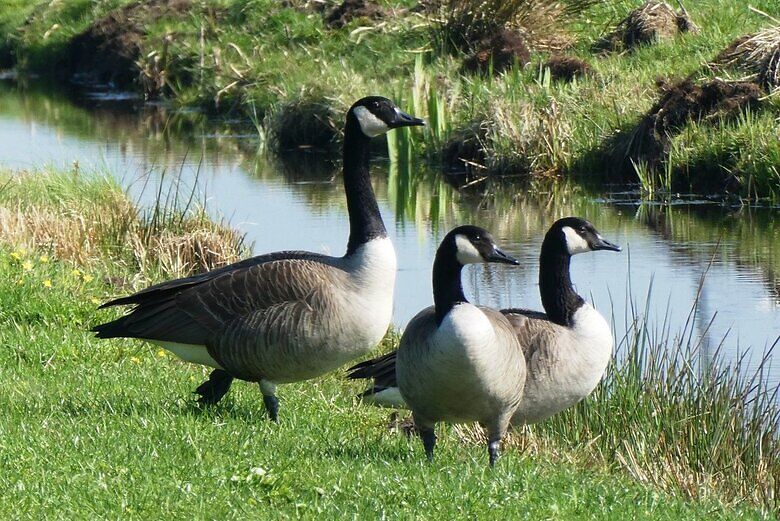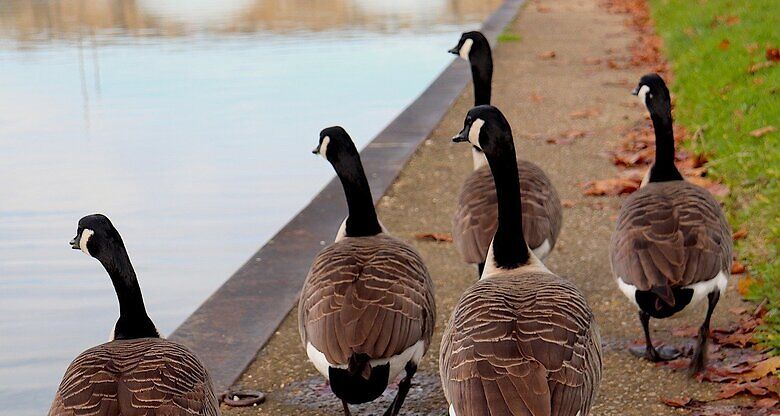About Nuisance Canadian Geese
It has become more and more normal for Canada geese to reside in flocks throughout urban and domesticated suburban areas. This is generally because of the attraction geese have to readily available resources like food, water, shelter, and grass.
It’s also generally safe for these birds due to the lack of apparent predator-activity in these areas.
In this article, we’ll be reviewing the biology of Canadaian geese, the problems that they cause, and what you can do to prevent and remove them from your property.

Biology
Appearance & Life Span
These birds range from 20-50 inches in length, while weighing in at an average of about 15-20 pounds. As they grow into adulthood, Canadian geese develop greyish/brown feathers with a long, distinct black neck. This species of bird has an average lifespan of 25 years. Depending on the circumstances, these birds are known to live up to 30+ years of age if all goes well, with an isolated case living to 40!
Diet
Canadian geese are grazers. In other words, as a primarily vegetarian species, Canadian geese largely feed on grass, vegetation, and other shrubbery, though they will sometimes branch out to feed on fish and such.
Habitat
These geese reside in a wide range of habitats, including but not limited to: wetlands, lakes and rivers, marshes, and are now being sighted in urban areas like parks, equipped backyards, and other public field-masses.
Parenting
A beautiful fact of Canadian geese is that they tend to stay in pairs for the duration of their lifetime. As such, they nest in pairs, as well. While these birds aren’t typically outwardly harmful, if approached with an apparent threat or disturbance, especially when protecting their young, they are known to intrinsically attack and protect due to their predisposed defense mechanisms.
Problems They Cause
Canadian geese present a wide range of problems, especially with regards to their newfound urban presence.
- As any such animal does, Canadian geese defecate wherever they see fit. When the accumulation of their feces and feathers occur on public grounds, this can cause a very large problem. Not only is it simply unattractive and unappealing to be around, but it also brings forth the potential of human public health hazards.
- Secondly, as mentioned in the biology portion of this article, Canadian geese are rightfully protective around their nests. If humans disturb or approach them, extreme aggression and harm may incur. This for obvious reasons is a problem.
- The third is the hazard to traffic and transportation. When any such wildlife enters suburban areas, it arises the same problem. No matter in the dark or during the day, the potential and possibility of these birds encountering a fatal accident with a vehicle collision are high.
- Lastly, because these birds are grazers to their core, another problem for property owners is the overgrazing of their property.

Prevention & Removal
- The first step to preventing these species from embarking onto your property is to make your site less attractive. If any wildlife has approached your property, it’s for a reason. Typically, it’s because of the readily available resources such as food, water, shelter, and in this case, grass and vegetation.
- In tandem with making your site less attractive, modifying the habitat is a similar tactic. If they have already made residence on your property, this may present a more difficult task. However, by modifying their habitat, they should get the hint that they’re not wanted.
- A good tactic to use if you have access to it is the utilization of a trained dog. These geese will not only feel harassed and uprooted by these dogs, but they will feel threatened as if it is a predator. The keyword here is ‘trained’. If you use an untrained pet dog, the potential for both harm to the dog and the bird is greatly increased. Not to mention potentially illegal.
- Lastly, and probably the most common-sense approach – install fenced barriers. Without further explanation needed, this can prevent the birds from entering in the first place!
For information on getting rid of Canada geese, see Getting Rid of Canadian Geese.
